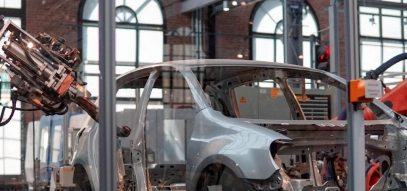
The road ahead: learning from the restarting automotive industry in China
Lessons from the restarting auto industry in China
27/04/2020
Restarting production around the world
After two years of recession, automotive production and sales fell further, by around 80% in China in February 2020, compared to 2019 figures. The following month saw a slight upswing, with production and sales down only 45% compared to March 2019. Part of the production and sales losses could be compensated by the fact that the Chinese New Year fell into the lockdown phase at the end of January.
Industry consequences, meanwhile, were varied: while production completely shut down in many plants, Chinese research and development centers restarted operation remotely after a slightly prolongated New Year holiday and in, some cases, were subject to only minor restrictions.
Despite the fall recorded in February, recovery did, in fact, start the same month – just a few days after lockdown. In Wuhan, the original epicentre of Covid-19, production restarted in March, involving some 700 foreign and Chinese automotive suppliers. By comparison, automotive production in Europe came to an almost complete standstill for around four weeks during March and April, and the restart has only taken place – gradually - since mid-April. The US and South America should see production restart from the beginning of May. Some companies have announced longer delays: Toyota in Brazil, for example, has said it will not go back into production before June.
There is hope in China that the sales lost during the lockdown phase can be caught-up in the remaining months of 2020. Notably, premium German manufacturers are recovering from the crisis in China faster than other brands. In March, two major German premium manufacturers recorded just a 15% fall in sales in China compared to the previous year.
Learning from the recovery in China
According to J. Salzmann, Mazars Managing Partner in Mainland China, automotive companies restarting production and sales must go to great lengths not to jeopardise the health of their employees: "If one employee is infected, this can ultimately lead to the closure of the entire company. The secret of China's rapid recovery is that we take epidemic prevention very seriously. In addition to the adequate provision of sufficient personal protective equipment such as masks and clinical thermometers, it is also important to control and track the travel and contact history of employees. Companies must be able to identify employees at risk of infection and isolate those who may be infected." The observance of personal hygiene and keeping enough distance at the workplace must be organised and monitored by the automotive companies.
A high degree of automation in production helps to maintain the desired safety distances. However, maintaining distances not only affects production processes, but also, for example, the seating arrangements in company canteens and in the self-operated buses that are widely used in Asian and South American automotive plants. Movement across factory premises, for instance, from the gate to the workplace, as well as behavior of the employees during breaks, must also be regulated.
Measures taken by companies in China to restart production were monitored on site by Chinese authorities. According to Sven Ammer, Böllhoff’s CEO Asia, Böllhoff received approval without any problems, as the various aspects had been well thought through by the in-house crisis management team. In addition, the personal data of employees returning to work must be reported to the authorities, and everyone’s return must be approved. However, the authorisations have been issued quickly, says Ammer - at Böllhoff they were usually processed within 24-36 hours. Even today, fever is measured three times a day and the personal risk status of the employees is available via the state-mandated tracking app with a clear documentation of the results. The measures taken by Böllhoff were so successful in China, he adds, that his colleagues in Europe are now following the example as they look to restart production.
Securing the supply chain
In addition to the health of the employees, the focus should also fall on securing the supply chain. China is extensively connected to the global automotive industry. It’s not just about materials, but also logistics. Although many supplier plants are located close to the original equipment manufacturers (OEMs), transport must be ensured for short distances. As it could not cross city or district borders in China during lockdown, Böllhoff transported goods by truck to the city borders and reloaded them onto another truck on the other side of the border. For deliveries to Europe, the US and South America, which are usually made by sea, many companies have switched to air freight to meet delivery deadlines. In the short term, some suppliers have increased their stock in order to react to the increasing OEM demand.
Reacting to new conditions
French global automotive supplier Faurecia has been forced to change its daily routine in response to the virus and currently operates a “no-touch” model at work, where teams switch between two shifts, with a one hour gap between them, to reduce the changes of infection, Yongwei Jiang, VP of Faurecia China Operations. Such a policy makes it possible for leadership to fill short-term absences with the back-up team, when necessary. In addition, during the lockdown phase, Faurecia succeeded in transferring production from Wuhan to other production facilities at an impressive speed, therefore reducing delays and shortages. In the future, new production facilities and processes will be planned to allow the more flexible use.
Looking ahead
Even if a significant catch-up is expected in China, it may take years for the global automotive industry to return to pre-crisis volumes. While a smaller decline in sales compared to the previous year is expected in the second half of 2020, the industry could undergo far-reaching changes.
Renault, for example, recently announced that it is withdrawing from its joint venture with Chinese state-owned automobile manufacturer Dongfeng and other well-known automotive companies could follow Renault’s lead. According to Salzmann, the crisis will also continue to drive consolidation in the Chinese automotive market, which currently counts more than 70 OEMs, especially local ones, and almost 500 projects and start-ups in the field of e-mobility alone.
“Covid-19 could have a diverse and long-term impact on the global automotive industry", predicts Dr. Christian Back, Global Head of Automotive at Mazars. For decades, the automotive industry has focused on optimising working capital. What was considered optimal in terms of financing and lean management is now being reconsidered by many automotive companies in terms of production capability. Supply chains are strongly controlled by the OEMs and it remains to be seen to what extent the OEMs will now push for greater regionalisation of supply chains in order to reduce dependency on international partners. However, the consequences of global crises and worldwide production lockdowns cannot be solved in this way, adds Back. Some OEMs are also currently rethinking their procurement strategies: potentially switching from currently one supplier per component to two or even more suppliers for each component. This would make OEMs better prepared in the case of further production lockdowns and individual supplier shortages.
The Covid-19 experience could open new opportunities for the automotive industry. Travelers could again increasingly prefer individual travel options, as the use of public transport is associated with a higher risk of infection. Or they could ask for the introduction of new in-car products, such as anti-virus functions as part of the air conditioning system, for instance. In addition, a short-term extension of contact-free online sales of new vehicles - moving traditional brands closer to Tesla’s approach – is plausible.
Despite the uncertainty of the road ahead for the automotive industry, there is cause for optimism as it restarts production and moves to meet customer demand. Yongwei Jiang looks positively into the future and believes we will find a fair balance between people's health and economic growth. What is certain is that whatever happens in China, the rest of the world will be watching.




